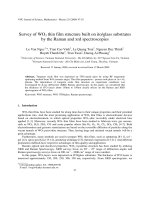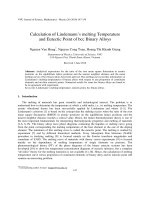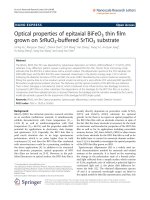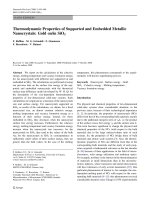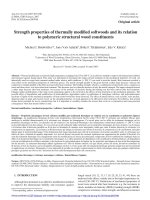- Trang chủ >>
- Khoa Học Tự Nhiên >>
- Vật lý
THERMODYNAMIC PROPERTIES OF CERIA THIN FILM TEMPERATURE AND PRESSURE DEPENDENCES
Bạn đang xem bản rút gọn của tài liệu. Xem và tải ngay bản đầy đủ của tài liệu tại đây (444.47 KB, 6 trang )
Proc. Natl. Conf. Theor. Phys. 37 (2012), pp. 144-149
THERMODYNAMIC PROPERTIES OF CERIA THIN FILM:
TEMPERATURE AND PRESSURE DEPENDENCES
VU VAN HUNG, TRAN THI THUY DUNG
Hanoi National University of Education
136 Xuan Thuy street, Cau Giay, Hanoi, Vietnam
LE THI THANH HUONG
Hai Phong University
Hai Phong, Viet Nam
Abstract. The moment method in statistical (SMM) dynamics is used to study the thermodynamic quantities of the CeO2 thin films taking into account the anharmonicity effects of the lattice
vibrations and influence of high pressure. The thermodynamic quantities of the CeO2 thin films
are calculated as a function of the temperature and pressure. The SMM calculations are performed
by using the Buckingham potential for the CeO2 thin films. In the present study, the influence of
temperature, pressure and thickness on the thermodynamic quantities of CeO2 thin film have also
been studied, using three different interatomic potentials. We discuss the temperature, pressure,
and thickness dependences of the thermodynamic quantities of the CeO2 thin films and compare
our calculated results with those of the experimental results.
I. INTRODUCTION
Extensive studies of elastic and thermodynamic properties of oxide materials (like as
cerium dioxide, and zicona ZrO2 ) appear because of their important applications in high
frequency resonators. These materials are systematically fabricated by film deposition
techniques in devices and their elastic constants are definitely required. Knowledge of
mechanical and thermodynamic properties of thin films is essential for designing MEMS
devices.
Cerium dioxide (or ceria) possesses a cubic fluorite structure with a lattice parameter
0
of 5.411 A , where in the unit cell the cations occupy the fcc lattice sites, while the Ce+4
anions are located at the eight tetrahedral sites. Cerium dioxide (CeO2 ) is important oxide
materials used as high and low index films in multi-layer optical thin film devices. CeO2
thin films have been deposited and characterized using different techniques [1]. Among
oxide materials, CeO2 has attracted more and more attention because of its desirable
properties such as high stability against mechanical abrasion, chemical attack and high
temperatures [2,3]. It is known that the size effect of the phonon frequency is attributed
to the phonon confinement, the surface pressure, or the interfacial vibrations. Therefore,
the understanding the size effect of elasticity on the thermodynamic properties and their
theoretical mechanism is important.
Most previous theoretical studies, however, are concerned with the materials properties of CeO2 bulk and thin film at absolute zero temperature, and temperature dependence
THERMODYNAMIC PROPERTIES OF CERIA THIN FILM
145
of the thermodynamic quantities have not been studied in detail. Temperature and pressure dependences of the thermodynamic and elastic properties of bulk cerium dioxide have
been studied using the analytic statistical moment method (SMM) [4,5,6]. The purpose of
the present article is to investigate the temperature, pressure and thickness dependences
of the thermodynamic properties of CeO2 thin film using the SMM [7].
II. THEORY
Usually, the theoretical study of the size effect has been carried by introducing
the surface energy contribution in the continuum mechanics or by the computational
simulations reflecting the surface stress, or surface relaxation influence. In the present
research, the influence of the size effect on thermodynamic properties of ceria thin film is
studied by introducing the surface energy contribution in the free energy of cerium and
oxygen ions of surface layers.
Let us consider a ceria free thin film of n layers with the film thickness d. Suppose
two top and bottom layers (surface layers) of ceria thin film are layers of cerium atoms.
Fig. 1. Ceria free thin film with the surface layers of cerium atoms.
Ceria free thin film consisting 2 cerium surface layers, 2 oxygen next surface layers,
and (2n-2) oxygen internal layers and (2n-1) cerium internal layers. The general expression
of the Helmholtz free energy ψ of cerium dioxide thin film is given as follows:
side
inter
Ψ = 2NCe Ψside
+ (2n − 1)NCe Ψinter
Ce + 2NO ΨO + (2n − 2)NO ΨO
Ce − T SC
(1)
where the numbers of cerium and oxygen ions of a layer are simply denoted by NCe = N0
inter
side
inter ) denote the free energy
and NO = 2N0 , respectively, Ψside
Ce (or ΨCe ) and ΨO (or ΨO
of Ce and O ions being on the surface (or internal) layers, respectively, and SC - the
configurational entropies. Pressure P is determined by
P =−
∂ψ
∂V
=−
T
a
3V
∂ψ
∂a
(2)
T
146
HUNG VU V., DUNG TRAN T T., HUONG LE T T.
From E.q (1), it is easy to derive an equation of states for a surface (or internal) of
ceria thin film at zero temperature
P v = −aside {CCe
1 ∂uside
o−Ce
+
6 ∂aside
side (0) ∂k side
ωCe
1 ∂uside
o−O
Ce
+
C
+
O
side
∂aside
6 ∂aside
4kCe
1 ∂uinter
o−Ce
+
6 ∂ainter
Ce (0) ∂k inter
ωinter
1 ∂uinter
o−O
Ce
+
C
+
O
inter
∂ainter
6 ∂ainter
4kCe
side (0) ∂k side
ωO
O
}
side
∂aside
4kO
(3)
inter (0) ∂k inter
ωO
O
}
inter
∂ainter
4kO
(4)
where P denotes the hydrostatic pressure and v is the atomic volume, ω(0) is the value of
side
inter (or uside ) represent the sum of effective
ω at zero temperature, uinter
Ce (or uCe ) and uO
O
pair interaction (or surface) energies for Ce and O ions being on the internal (or surface)
layers in ceria thin film
P v = −ainter {CCe
Ce−inter
φio
(|ri |) and uinter
=
O
uinter
Ce =
i
uside
Ce
φO−inter
(|ri |)
io
(5)
φO−side
(|ri |)
io
(6)
i
Ce−side
φio
(|ri |)
=
and
uside
O
i
=
i
and ω is the atomic vibration frequencies, and it can be approximated in most cases to
the Einstein frequency ωE , given by
k=
1
2
i
∂ 2 φio
∂u2ix
2
≡ mωE
(7)
eq
and φio is the interatomic potential energy between the central 0th and ith sites, and uix
is the atomic displacement of the ith atom in the x-direction.
Using Eqs.(3) and (4), one can find the nearest neighbor distance at pressure P
and zero temperature T = 0K, a(P, 0). It is known that the Buckingham potential has
been very successful for calculations of thermodynamic properties of CeO2 . The atomic
interactions are described by a potential function which divides the forces into long-range
interactions (described by Coulombs Law and summated by the Edwald method) and
short-range interactions treated by a pairwise function of the Buckingham form
qi qj
Cij
r
+ Aij exp(−
)− 6
(8)
r
Bij
r
where qi and qj are the charges of ions i and j respectively, r is distance between them
and Aij , Bij and Cij are the parameters particular to each ion-ion interaction. In the
Eq.(8), the exponential term corresponds to electron cloud overlap and the last term
corresponds to the attractive dispersion or Van der Waals force. Potential parameters
Aij , Bij and Cij have most commonly been derived by the procedure of empirical fitting,
i.e., parameters are adjusted, usually by a least-squares fitting routine, so as to achieve
the best possible agreement between calculated and experimental crystal properties. The
potential parameters are listed in the Table 1.
φij (r) =
THERMODYNAMIC PROPERTIES OF CERIA THIN FILM
147
In principle Eqs.(3), and (4) permit to find the nearest neighbor distance aside (P, 0)
(or ainter (P, 0) at zero temperature for the surface (or next surface) layer, or internal
layer. Using the MAPLE program, Eqs.(3), and (4) can be solved and we find the values
of the nearest neighbor distances aside (P, 0) and ainter (P, 0). We assume that the average
nearest-neighbor distance of the surface layers and internal layers for cerium dioxide thin
film at temperature T can be written as
side
side
aside (P, T ) = aside (P, 0) + CCe yCe
(P, T ) + CO yO
(P, T )
(9)
inter
inter
ainter (P, T ) = ainter (P, 0) + CCe yCe
(P, T ) + CO yO
(P, T )
(10)
side (P, T ) (or y inter (P, T )), and y side (P, T ) (or y inter (P, T )) are the atomic
in which yCe
Ce
O
O
displacements of Ce and O atoms from the equilibrium position in the surface (or internal)
layers.
The thickness d of thin film can be given by
d = 2aside (P, T ) + (n − 2)ainter (P, T )
Therefore, the average lattice constant a(P, T ) of thin film is determined as
(11)
2aside (T ) + (n − 2)ainter (T )
d
=
(12)
n
n
Using Eqs. (9), and (10), and defination of the thermal expansion coefficient, it
is easy to obtain the expression of the thermal expansion coefficient for the surface and
internal layers
a(T ) =
inter
inter
inter
αCeO
= CCe αCe
+ CO αO
2
(13)
side
side
side
= CCe αCe
+ CO αO
αCeO
2
(14)
Where
inter
αCe
(P, T ) =
inter (P, T )
dyCe
kB
ainter (P, 0)
dθ
inter
αO
(P, T ) =
inter (P, T )
dyO
kB
ainter (P, 0)
dθ
side (P, T )
dyCe
kB
(15)
aside (P, 0)
dθ
side (P, T )
dyO
kB
side
αO
(P, T ) =
aside (P, 0)
dθ
Therefore, the average thermal expansion coefficient of CeO2 thin film can be determined
in the approximate form:
side
αCe
(P, T ) =
αthin f ilm =
side
inter inter
2aside
01 αCeO2 + (n − 2)a01 αCeO2
inter
2aside
01 + (n − 2)a01
(16)
148
HUNG VU V., DUNG TRAN T T., HUONG LE T T.
2
∂ ψ
CV = −T ∂T
2 =
6
inter
6n+1 CV
+
6n−5 side
6n+1 CV
= CVinter +
6
6n+1
CVside − CVinter
(17)
III. Results and discussion
In this section we compare lattice constant of internal layer for CeO2 thin film to
some experimental and other theoretical results.
In Figs.3 and 4 we present the temperature and thickness dependence of the lattice
constant and thermal expansion coefficient of ceria thin film using the potentials 1, 2 and
Butler potential. Figs 3 and 4 show the lattice constant and thermal expansion coefficient
of ceria thin film, calculated by using the Buckingham potentials, as a function of the
thickness d of thin film. One can see in Figs.3 and 4 that the lattice constant and thermal
expansion coefficient increase with the thickness d, when the thickness d ≥ 400A0 (or the
number n of layers of thin film n ≥ 80 the average lattice constant a(T ) and thermal
0
expansion coefficient of thin film (a(T ) ∼ 5.41 A) in agreement with the experimental
THERMODYNAMIC PROPERTIES OF CERIA THIN FILM
149
results of bulk CeO2 . In Figs.2 we depict the temperature dependence of SMM lattice
parameter of CeO2 thin films using the potentials 1, 2 and Butler potential.
Figs 5 show the speciffic heat Cv of ceria thin films, calculated by using the Buckingham potentials, as a function of the pressure.
IV. Conclusions
In conclusion it should be noted that the statistical moment method really permits
us to investigate the temperature, pressure, and thickness dependences of CeO2 thin films.
The results obtain by this method are in good agreement with the experimental data. We
have calculated thermodynamic quantities for CeO2 thin films with different thickness
using potentials 1, 2 and Butler potential at various pressures, and these calculated SMM
thermodynamic quantities are in good agreement with other calculations and experiment
for bulk CeO2 . This research is funded by Vietnam National Foundation for Science and
Technology Development (NAFOSTED) under grant number 103.01-2011.16
REFERENCES
[1]
[2]
[3]
[4]
L. N. Raffaella, G. T. Roberta, M. Graziella, and L. F. Ignazio, J. Matter. Chem.,15(2005) 2328-2337.
A. J. Farah et al.,J. of Nuclear and Related Tech.Vol. 6, No. 1(2009) 183.
K. N. Rao, L. Shivlingappa, and S. Mohan, Mater. Scien. and Engineering, B 98(2003) 38-44.
V.V.Hung, B.D. Tinh, and Jaichan Lee, S. Ohnuma, A. Natori, Modern Phys. Letter B Vol.25
No.12&13 (2011)1001-1010.
[5] V. V. Hung, L. T. M. Thanh, and K. Masuda-Jindo, Comput. Mat. Science Vol.49 (2010)355-358.
[6] V. V. Hung and L. T. M. Thanh, Physica B 406 (2011) 4014-4018.
[7] V. V. Hung, J. Lee, and K. Masuda-Jindo, J. Phys. Chem. Sol 67 (2006) 682-689.
Received 02-09-2012.
